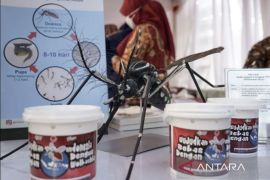"Actually, the WHO (World Health Organization) has also said that incidents (of bird flu transmission to humans) in Cambodia were rare events, but could happen," he pointed out during an online discussion, which was followed from here on Thursday.
"That means the possibility of transmission risk still exists. So, we cannot underestimate bird flu," he added.
However, Nidom said that the public does not need to worry because until now, there have been no incidents of human-to-human bird flu transmission.
"Currently, the virus is only transmitted from birds to certain people around them," he added.
This is because the attachment sites or receptors for the bird flu virus are different from the receptors for the seasonal flu virus, which can spread among humans, Nidom explained.
The bird flu virus receptor is sialic acid (SA) alpha-2,3, which is abundant in birds or poultry.
Meanwhile, the seasonal influenza virus receptor in humans is alpha-2,6 galactose, which is abundant on the surface of the cells of the upper respiratory tract organs.
Nidom said the transmission of the bird flu virus to humans can occur if the concentration of the virus is very high.
For example, if a person with poor immunity enters an area with a very high concentration of the virus, it will be quite possible for the virus to enter their respiratory tract, he said.
"When (the virus) enters, it makes adjustments to the receptors in our bodies. The virus also carries out replication activities and so on," said Nidom.
The mode of transmission is direct contact or from surfaces contaminated with the virus, he informed.
"Direct contact can occur when (birds) feces or viruses that are on the surface of the skin of birds fly, then they are inhaled by humans," he said.
"While transmission through contaminated surfaces is when we touch chicken skin that is contaminated with the virus. The virus can enter the body through the nose or eyes," he expounded.
Thus, Nidom said that the risk of bird flu infection in humans remains open. Therefore, bird flu control must be carried out by all stakeholders.
Communities can prevent a bird flu infection by implementing health protocols, such as wearing masks and keeping a distance from live birds.
It is also advisable for people to maintain their health by consuming vitamins and herbs such as ginger, as well as taking flu or bird flu vaccinations when they are available.
Related news: Ministry investigating dozens of poultry deaths in South Kalimantan
Related news: Health Ministry wary of bird flu infection transmission to humans
Translator: Suci Nurhaliza, Katriana
Editor: Rahmad Nasution
Copyright © ANTARA 2023












